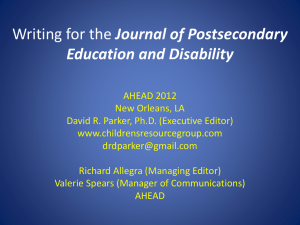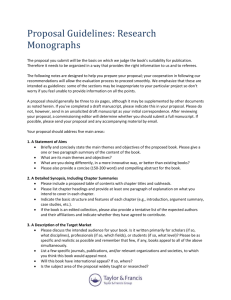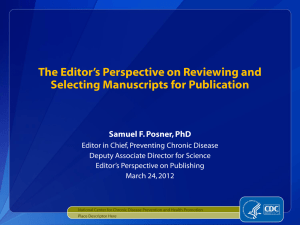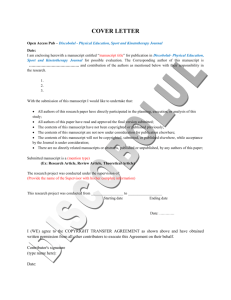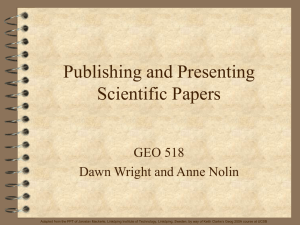Guest Editor Guidelines TGIE
advertisement
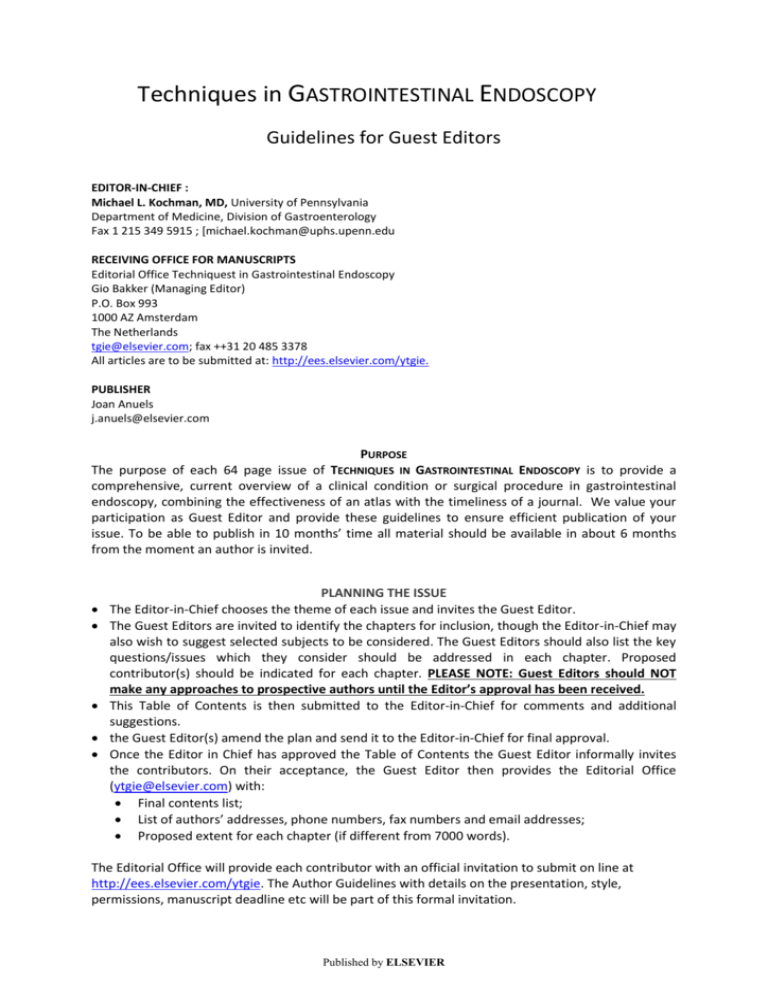
Techniques in GASTROINTESTINAL ENDOSCOPY Guidelines for Guest Editors EDITOR-IN-CHIEF : Michael L. Kochman, MD, University of Pennsylvania Department of Medicine, Division of Gastroenterology Fax 1 215 349 5915 ; [michael.kochman@uphs.upenn.edu RECEIVING OFFICE FOR MANUSCRIPTS Editorial Office Techniquest in Gastrointestinal Endoscopy Gio Bakker (Managing Editor) P.O. Box 993 1000 AZ Amsterdam The Netherlands tgie@elsevier.com; fax ++31 20 485 3378 All articles are to be submitted at: http://ees.elsevier.com/ytgie. PUBLISHER Joan Anuels j.anuels@elsevier.com PURPOSE The purpose of each 64 page issue of TECHNIQUES IN GASTROINTESTINAL ENDOSCOPY is to provide a comprehensive, current overview of a clinical condition or surgical procedure in gastrointestinal endoscopy, combining the effectiveness of an atlas with the timeliness of a journal. We value your participation as Guest Editor and provide these guidelines to ensure efficient publication of your issue. To be able to publish in 10 months’ time all material should be available in about 6 months from the moment an author is invited. PLANNING THE ISSUE The Editor-in-Chief chooses the theme of each issue and invites the Guest Editor. The Guest Editors are invited to identify the chapters for inclusion, though the Editor-in-Chief may also wish to suggest selected subjects to be considered. The Guest Editors should also list the key questions/issues which they consider should be addressed in each chapter. Proposed contributor(s) should be indicated for each chapter. PLEASE NOTE: Guest Editors should NOT make any approaches to prospective authors until the Editor’s approval has been received. This Table of Contents is then submitted to the Editor-in-Chief for comments and additional suggestions. the Guest Editor(s) amend the plan and send it to the Editor-in-Chief for final approval. Once the Editor in Chief has approved the Table of Contents the Guest Editor informally invites the contributors. On their acceptance, the Guest Editor then provides the Editorial Office (ytgie@elsevier.com) with: Final contents list; List of authors’ addresses, phone numbers, fax numbers and email addresses; Proposed extent for each chapter (if different from 7000 words). The Editorial Office will provide each contributor with an official invitation to submit on line at http://ees.elsevier.com/ytgie. The Author Guidelines with details on the presentation, style, permissions, manuscript deadline etc will be part of this formal invitation. Published by ELSEVIER FORMAT The customary table of contents includes a preface by the Guest Editor and 8-12 articles. The core of the issue will describe the surgical procedure or the clinical condition in detail. Articles by surgeons describing differing approaches to the same procedure may be included. Other articles may discuss current advances, diagnostic concerns, therapeutic techniques, preoperative and postoperative management, long-term results, or other critical information related to your topic. ILLUSTRATIONS To make effective use of the atlas format, the Guest Editor is encouraged to begin planning for illustrations as the table of contents is drafted. The format will accommodate four pages of 4colour illustrations per issue. As Guest Editor, you are asked to allocate the four pages of colour where you feel they will be most effective. Up to six illustrations can appear on each page. The selected images will be posted in the printed version in color or black and white at no cost. Each contribution should not have more than 2 color illustrations. Authors will have to be pay for any additional color illustrations in the printed publications; color illustrations in the on line publication are however free of charge For further details on illustrations, please consult http://www.elsevier.com/artworkinstructions Contributing authors are encouraged to submit radiographs, photographs, and camera-ready line drawings with their manuscripts. Video files can be part of the on line publication. As Guest Editor, you may wish to make specific recommendations regarding illustrations to individual authors when you invite them for participation in this issue. Authors can be requested to submit supplementary figures and tables as part of the on line publication only. These supplementary tables and figures are to be referred to in the text as Table S-1 or Figure S-1, etc. REVIEW Once a manuscript is submitted you should have at least 2 months for the review process. We would like to avoid any delays in publication of your issue and it is therefore recommended that you edit and review each manuscript as they are put into your queue and not to wait for all contributions to be available. That allows the EIC to review the manuscript and ample time for the authors to revise their contribution should that be necessary. The Guest Editor, as primary reviewer, has full authority and responsibility for initial review, rejection, recommended modification, and personal editing of each manuscript. It is also recommended to invite one or more reviewers for each manuscript. This will help you in the evaluation of each manuscript. Please strive for uniformity in the articles' approach to the subject matter and delete material as necessary to avoid repetition. Responsibility for accuracy, timeliness, and completeness of the final manuscript rests with the authors. Any substantive modification of an author's work requires the author’s approval. LENGTH OF MANUSCRIPT It is important that your published issue contain no less than 58 printed pages and no more than 64 printed pages. The following approximations are offered to help you calculate page allocations: 3 8½ X 11 inch pages, double-spaced, with 1½ inch margins, in standard 10- or 12-point word processor type (approx. 250 words per page) = 1 printed page 4 tables or figures with legends = 1 printed page 35 references (all lines double-spaced) = 1 printed page Published by ELSEVIER Example: A manuscript contains 15 pages of text with 17 references, and 6 tables. 15 pages of text 6 figures or tables 17 references = 5 printed pages = 1½ printed pages = ½ printed page 7 printed pages We need your cooperation in limiting the issue to 64 pages. Exercise judgment in deleting text, or requesting authors to convert verbose text into a table or to use illustrations instead. Figures or tables can also be included as on line publication only supplementary tables or figures. PROCESS Your first task is to develop an initial table of contents for your issue by selecting 8-10 topics for articles and identifying a tentative author for each article. The table of contents should include the approximate length in printed pages anticipated for each article. A manuscript typically consists of 612 manuscript pages including tables and illustrations. The Guest Editor is expected to write a brief preface (1-2 printed pages), but you may elect to write an article or not, as you prefer. The table of contents with a tentative list of corresponding contributors should be sent to the Editor in Chief as soon as possible for approval before you contact contributors. It would be appreciated if you would supply the contributors' names, degrees, affiliation, (addresses, telephone, fax number) and e-mail address with the initial table of contents. The Managing Editor will register the authors in EES and send the formal author invitation electronically INVITATIONS TO CONTRIBUTORS Once the Editor has approved your table of contents the authors are to be invited formally asking them to agree or decline within 14 days. The Author invitation will include the proposed article title, the page limit for the article, the deadline, and a copy of the Guidelines for Contributing Authors. Please inform us if you prefer us to contact authors in person instead. In principle authors are asked to deliver within 2 months. Authors are most welcome to submit earlier than that. MANUSCRIPT PREPARATION & PUBLICATION Please refer to the author guidelines for specific instructions on manuscript preparation. Authors are given the option to publish Open Access instead of Subscription-based. In case of Open Access and author fee is required. Please check the description in the AuthorGuidelines. Initial and revised manuscripts are to be submitted on line. You will be able to edit manuscripts for the author if so desired. Each author will be responsible for proofreading the typeset galleys for his or her article. The Guest Editor is responsible for assisting the publisher in following up with the authors who are late in returning galleys. Please cooperate if the publisher calls you for assistance in obtaining late author corrections. Page proofs are only sent to the Editor in Chief Instructions for using Elsevier Editorial System (EES) as Guest Editor Logging in and viewing your Main Menu: To visit the Elsevier Editorial System (EES) online submission site go to: http://ees.elsevier.com/ytgie/ Log in to the system using the username and password you received from the Editorial Office and choose "Editor Login". Once logged in you will reach your personal “Guest Editor” Main Menu. Published by ELSEVIER After you have logged in to the system, you will be able to change your username and password at any time, by clicking on the “change details” link (located on the top of the screen, under the journal name). Manuscript Assignment and Notification of Assignment The manuscript will be assigned to you by the Editorial Office. As Guest Editor, you will receive notification of a new assignment by e-mail. This e-mail will include a reminder of your username and the website address for the EES system. New Assignments Click on "New Assignments" in the main menu to see all new manuscripts assigned to you. Select a submission that you wish to review and click “View Submission”. A pop-up window appears in which you are asked to download the PDF of the submission to your computer. Click “Open”. (Depending on your computer settings, you might have to click “Save” and then again “Open”). You can now view the PDF, which contains the manuscript and possible figures and/or tables. The PDF might also contain a cover letter for the editorial office, a signed offprint order form or a signed copyright transfer form. You can ignore these, since you will only need to view the manuscript (and possibly figures and tables). Click on "Details" to view details about the manuscript or notes from the Editorial Office. Note: You must have Adobe Acrobat installed on your computer to view or download the manuscript PDF. If you do not have this software installed on your system, you can download the free Adobe Acrobat Reader by simply clicking on the following link: http://www.adobe.com/products/acrobat/readstep2.html Reviewer Invitations Authors will be asked to suggest reviewers for this manuscript. You may however prefer to invite a member of the Editorial Board or another colleague to evaluate the contents and presentation. Please send the names (affiliation, town) and preferably their e-mail address of preferably 2 or 3 reviewers to tgie@elsevier.com . The Editorial Office will invite reviewers, remind them and contact you if additional reviewers are required. The invitations will bear the signature of the Editor in Chief. As Guest Editor you will be informed by e-mail once a reviewer report becomes available. Submit a recommendation When you have reviewed a manuscript, please make a decision in the on line system. To do so, locate the manuscript ( in the folder"New Assignments or Manuscripts with Required reviews complete") and click on “Submit Editor’s Decision and Comments”. The manuscript will then automatically move to the Editor in Chief for his input. Use the dropdown menu at the top of the next screen to make your decision. For example, you can choose “Accept” in the decision-box if you want to accept the article without modifications. However, you can also ask for a revision of the article (“Revision”). When you request a revision, please type your comments in the “Comments to Author” area at the bottom of the screen. Please note that these comments are anonymous and may be changed by the editorial office or Editor in Chief when necessary. Published by ELSEVIER When you have made a decision, click “Proceed”. In the screen that appears you can perform a final check of your decision. You may choose to make alterations to your decision by clicking “Edit Decision”. This will bring you back to the previous screen. Once you are satisfied with your decision, click “Submit Decision”. Once you have submitted your recommendation, the submission will move into your Completed Assignments. The information will remain available in this folder for future reference. This concludes your work for a specific article unless a revision is required. Note that you can check the progress of an article by looking under “Submissions with Decisions” in your Editor main menu. SCOPUS As Guest Editor you can access SCOPUS the world’s largest abstract and citation database of research information and quality internet sources. Scopus can be accessed with the journal acronym and your EES username and password either at www.scopus.com/editors or via EES using the SCOPUS or SCIENCE DIRECT picture link on the ‘Invite Reviewers’ page Searching Manuscripts By using the “Search Submissions” option (located on the top of your Main Menu), you can search for any manuscript in the system. By clicking on the “down arrow” next to “Manuscript Number” you can select the search criterion. You can add more search criteria by clicking on the “ADD” or “OR” button. Typically a manuscript is searched for by its manuscript number. In that case select the following: Criterion = Manuscript Number Selector = Containing Value = (part of the) manuscript number Searching People The “Search People” option is also located on your Main Menu. You can select from a list of search criteria (including Last Name, First Name, e-Mail Address) to find people. If you have found the person you were looking for, click on the name to access more detailed information. Here you can, for example, click on the button “Activity Details” to see the activities of the person as author or as reviewer. Other information such as Personal Classifications and Unavailable Dates can also be accessed from here. If you have any question, please contact the Managing Editor at tgie@elsevier.com. Published by ELSEVIER A concept e-mail in case authors would send their submission to you, instead of submitting on line: Dear Dr Thank you for your article. You submitted the manuscript as e-mail attachment or hardcopy to the journal Techniques in Gastrointestinal Endoscopy. Hardcopy submissions, e-mails, or disks are however no longer used for the editorial process. . TGIE is using Elsevier Editorial System, an online submission and review system at <http://ees.elsevier.com/ytgie> We look forward to receiving your submission online via the Techniques in Gastrointestinal Endoscopy website. You are registered at the website. The username and password will be resent to you when you push the button “send username/password” on the login screen. Go back to the website, click "login" (middle top menu), enter your username and password and click the "Author login" button. Click the link "Submit new manuscript" to upload the submission. Please use separate files for text, tables and each figure. Once these files are in the correct order push "next" and "build pdf". After some time you can view and approve the resulting file. If you have any technical difficulties whatsoever, please do not hesitate to contact the Managing Editor at tgie@elsevier.com or Elsevier's Author Support Department at authorsupport@elsevier.com Thank you in advance. Kind regards, Published by ELSEVIER

